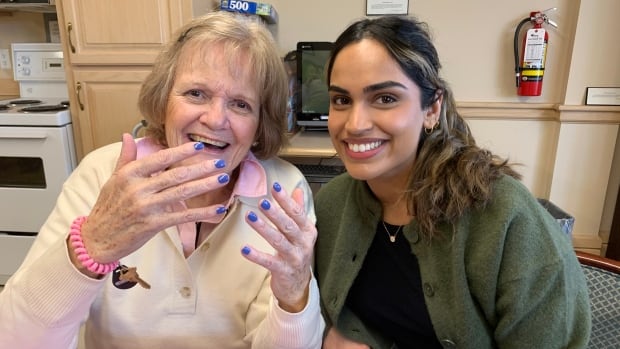Janet Nevala has walked for exercise her whole life, but about 10 years ago she added a new element to her jaunts — walking backwards.
“Every time I walk, I just do a little twirl and walk backwards for a bit, and I’ll do it just a few times during my walk,” said the 62-year-old nurse, who lives in Notre-Dame-du-Portage, Que.
“People do kind of look at me. I’ve had a couple of smiles,” she told The Current.
Nevala was on a normal forward-moving walk one day when her foot caught in a pothole and she fell. She wasn’t hurt, but felt humiliated. When she later heard that backwards walking can help with balance, she started adding it to her routine — and found she liked the challenge.
“I feel like I’m mastering something, so because I’m 62, I feel like … ‘Gee, look at me!'” she said.
“The balance part is really important because I don’t want to fall again.”

Videos and tutorials about walking backwards have been popping up on social media recently, but biomechanist Janet Dufek has been studying this form of exercise for about 20 years.
“It had been somewhat trendy and hip many years ago, I’d say in the late 1980s, 1990s, and had gone dark for a bit. So it’s the new fad that’s being revisited,” said Dufek, a professor of kinesiology and nutrition sciences at the University of Nevada.
Back in the 1980s, Dufek was involved in the development of what became the elliptical trainer, and was instrumental in the exercise machine having both forward and reverse motion.
Dufek said she and her fellow researchers were convinced that backward motion had added benefits for strengthening muscles that normal forward motion did not. Her subsequent research into walking backwards has shown that there’s less impact on the joints by using these different muscles — and it can increase flexibility and even help alleviate back pain.
Her work has also focused on older adults, and found “that incorporating backward walking into a regular exercise routine can, in fact, enhance static balance.”

Dufek said that can be extremely important to help older adults avoid a fall, which can take both a physical and psychological toll.
“Once they have that first fall, they have a fear of falling and that could in fact discourage them from participating in any activity. So it compounds itself,” she said.
‘Less impact, greater benefit’
In Vancouver, clinical exercise specialist and educator André Noël Potvin says walking backwards helps with the physical changes of getting older, such as shifts in gait and posture.
“We don’t spend a lot of time working on the back part of our body,” said Potvin, founder and president of Infofit Fitness Career College, which provides training for fitness instructors.
“When you start to walk backwards, you actually start to rebalance the forces around the ankle, knee, hip and lower back.”
Potvin said he’s helped hundreds of people try backwards walking, ever since he found it helpful while recovering from knee replacement surgery in 2008.
“One of the key things that happens when walking backwards is the ankle absorbs shock differently and therefore it gets stronger,” he said.
“People who have foot problems, ankle problems, knee problems, hip problems or back problems … they start to notice less impact and greater benefit.”
Potvin pointed out that plenty of seniors have robust exercise routines, saying he’s worked with a 75-year-old who can do 15 full chin-ups, and a 79-year-old who can do 40 full push-ups.
Backwards motion can also be part of a high-performance workout, he added.
“When I’m on the treadmill, I’m walking backwards at like four miles per hour and I’m walking on a six or eight per cent incline, which is quite a bit of a challenge,” he said.
“Take that and you apply it to the field where the individuals have to run backwards, say in soccer or rugby or football or whatnot, then it has a great transferability to it.”

Dufek cautioned that the benefits to be gained depend on a person’s baseline fitness.
“If you, for example, take a very fit, college-age student, they may have lesser intense outcomes than someone who is basically a couch potato and is just starting,” she said.
Start slow, look ‘a little weird’
Taking up walking backwards does involve some risk, particularly around tripping and falling if you can’t see where you’re going.
Potvin said people are often hesitant when he tries to introduce them to backwards walking, but they quickly gain trust and confidence.
He said the trick is to start very slow — perhaps 0.5 mph [0.8 kph] on a treadmill, holding the handrails — and gradually increase the speed to match your comfort level.
If someone doesn’t have access to a gym or equipment, Potvin said a flat outdoor path is fine, ideally with a handrail. Walking with a partner who can watch for obstacles helps, but even short backwards walks of just 20 seconds is a good way to start, he said.
WATCH | How to approach walking backwards on a treadmill:
“It’s all about encouragement with just a little bit of a tease … a little challenge,” he said.
“Then they feel successful … and then they want to do more.”
Dufek said people shouldn’t worry about what others might think. She recalled when one of her students was walking backwards on a treadmill and “a lot of people were kind of chuckling, laughing at him.”
“The next day he came into the gym and all these people were walking backward on the treadmill,” she said.
“It’s like, ‘Hey, that looks a little weird. Let me try it.'”







